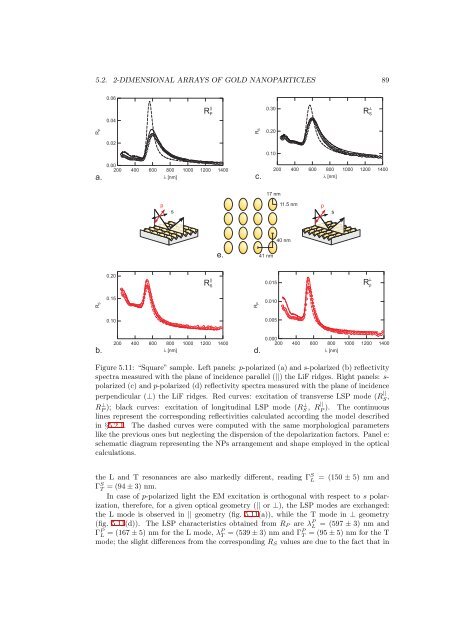88 CHAPTER 5. MODELLING AND ANALYSIS OF THE OPT. PROP.[001]30Counts [%]2010ab01.02.0Aspect ratio1510Counts [%]105Counts [%]5c0510 15NP lenght [nm]20d0510 15NP width [nm]20Figure 5.10: Panel a: AFM image <strong>of</strong> a nanopatterned LiF(110) sample with Λ ≈ 30 nm,following the grazing deposition <strong>of</strong> ≈ 3 nm <strong>of</strong> gold at T = 100 ◦ C <strong>and</strong> annealing atT = 400 ◦ C (“rectangular” configuration). Panels b, c, d: statistical distributions <strong>of</strong> theNP in-plane aspect ratio <strong>and</strong> semiaxes along <strong>and</strong> across the LiF ridges, respectively. Thecontinuous lines are best-fit lognormal probability density functions. See text for details.along <strong>and</strong> across the LiF ridges, were characterized by very similar parameters, exhibitinga mean <strong>and</strong> a st<strong>and</strong>ard deviation <strong>of</strong> a x = a y = (8.5 ± 3.0) nm, corresponding to anaspect ratio <strong>of</strong> 1.0 ± 0.3. Mean NP spacings <strong>of</strong> d y = (20 ± 5) nm along the chains <strong>and</strong>d x = (30±5) nm across the ripples were found, indicating that the particles can be statisticallythought as laying on a rectangular mesh. We will refer to this class <strong>of</strong> samplesas the “rectangular” <strong>arrays</strong>.Optical characterizationIn analogy with the previous cases, the optical response <strong>of</strong> the samples under scrutinyhas been investigated by means <strong>of</strong> polarized light reflectivity, with the plane <strong>of</strong> incidenceeither along (||) or across (⊥) the LiF ridges, in order to selectively discriminate thecontributions <strong>of</strong> the individual L <strong>and</strong> T <strong>plasmonic</strong> modes (see §4.2.3).In fig. 5.11 <strong>and</strong> fig. 5.12 we report, as open circles, R S (panels (b)) <strong>and</strong> R P (panels (c))spectra measured for the “square” <strong>and</strong> the “rectangular” samples, respectively, at θ = 50 ◦<strong>of</strong> incidence. For each polarization, the longitudinal <strong>and</strong> transverse LSP modes have beenexcited by fixing the plane <strong>of</strong> incidence in parallel or perpendicular configuration: L mode(black lines) excited in RS ⊥ , T mode (red lines) excited in R||S , <strong>and</strong> vice versa for R P.The in-plane optical anisotropy <strong>of</strong> the system is particularly accentuated for the“square” configuration, reported in fig. 5.11: looking at R S , the L <strong>and</strong> T modes areexcited by setting the plane <strong>of</strong> incidence perpendicular (⊥, fig. 5.11(c)) <strong>and</strong> parallel (||,fig. 5.11(b)) to the LiF ridges, respectively, <strong>and</strong> are found at λ S L = (597 ± 3) nm <strong>and</strong>= (542 ± 3) nm, separated by ≈ 55 nm; the full widths at half maximum (Γ) <strong>of</strong>λ S T
5.2. 2-DIMENSIONAL ARRAYS OF GOLD NANOPARTICLES 890.060.04R P||0.30R S┴R PR S0.200.020.100.00a.200 400 600 800 1000 1200 1400 [nm]c.200400600800 [nm]10001200140017 nmps11.5 nmps40 nme.41 nm0.20R S||0.015R p┴R S0.15R P0.0100.100.005b.200400600800 [nm]100012001400d.0.000200400600800 [nm]100012001400Figure 5.11: “Square” sample. Left panels: p-polarized (a) <strong>and</strong> s-polarized (b) reflectivityspectra measured with the plane <strong>of</strong> incidence parallel (||) the LiF ridges. Right panels: s-polarized (c) <strong>and</strong> p-polarized (d) reflectivity spectra measured with the plane <strong>of</strong> incidenceperpendicular (⊥) the LiF ridges. Red curves: excitation <strong>of</strong> transverse LSP mode (R ||S ,RP ⊥); black curves: excitation <strong>of</strong> longitudinal LSP mode (R⊥ S , R|| P). The continuouslines represent the corresponding reflectivities calculated according the model describedin §5.2.1. The dashed curves were computed with the same morphological parameterslike the previous ones but neglecting the dispersion <strong>of</strong> the depolarization factors. Panel e:schematic diagram representing the NPs arrangement <strong>and</strong> shape employed in the opticalcalculations.the L <strong>and</strong> T resonances are also markedly different, reading Γ S L = (150 ± 5) nm <strong>and</strong>Γ S T = (94±3) nm.In case <strong>of</strong> p-polarized light the EM excitation is orthogonal with respect to s polarization,therefore, for a given optical geometry (|| or ⊥), the LSP modes are exchanged:the L mode is observed in || geometry (fig. 5.11(a)), while the T mode in ⊥ geometry(fig. 5.11(d)). The LSP characteristics obtained from R P are λ P L = (597 ± 3) nm <strong>and</strong>Γ P L = (167±5) nm for the L mode, λP T = (539±3) nm <strong>and</strong> ΓP T = (95±5) nm for the Tmode; the slight differences from the corresponding R S values are due to the fact that in
















